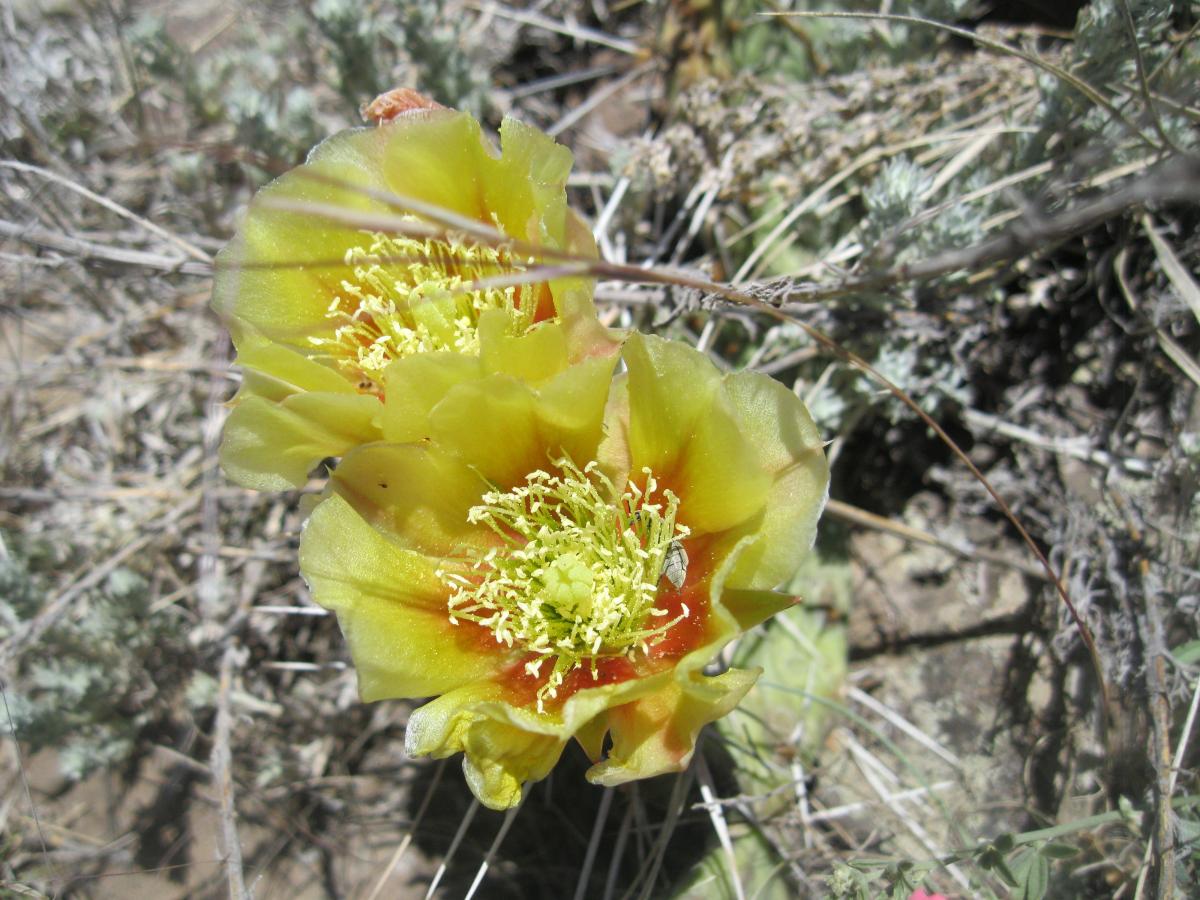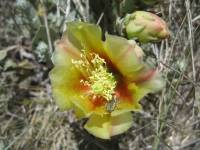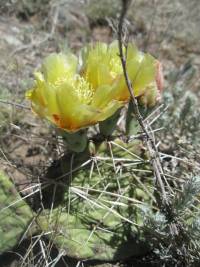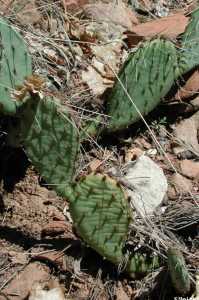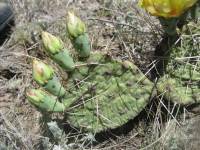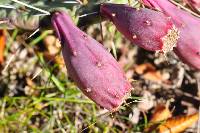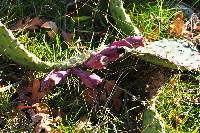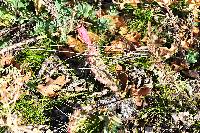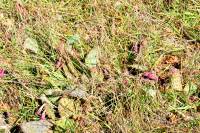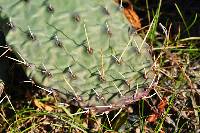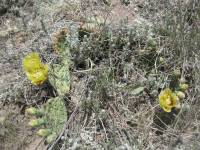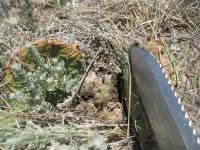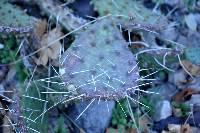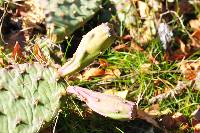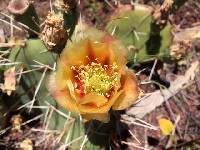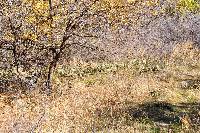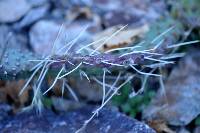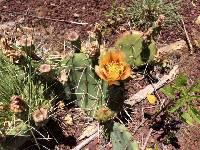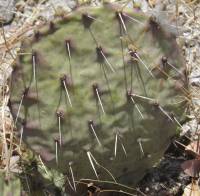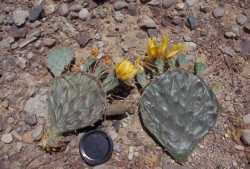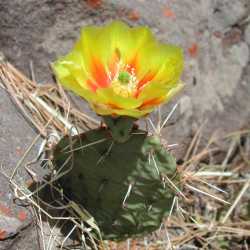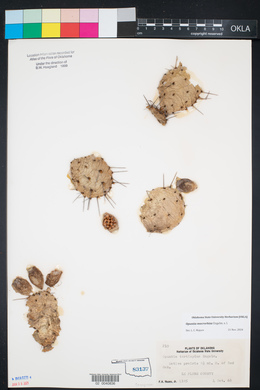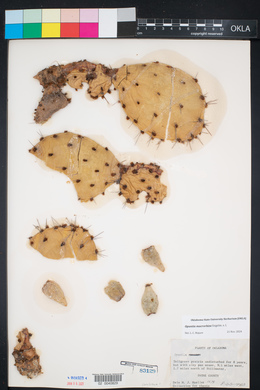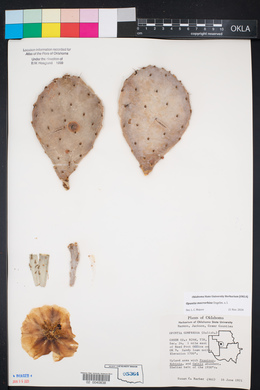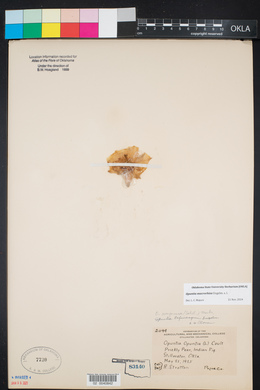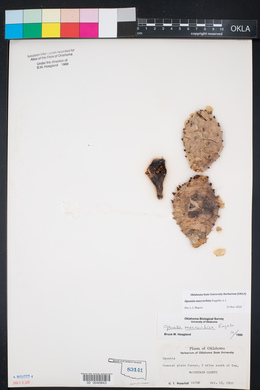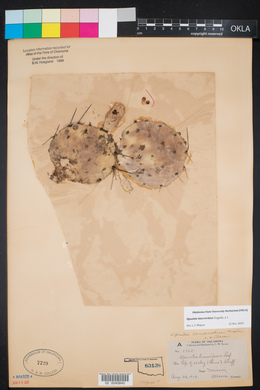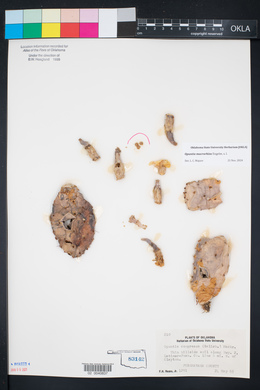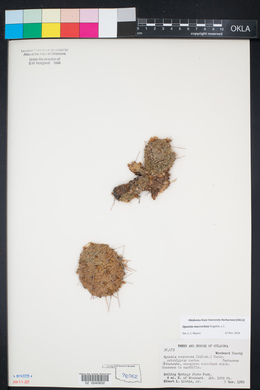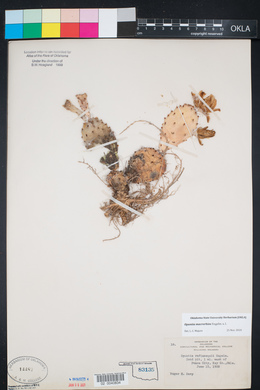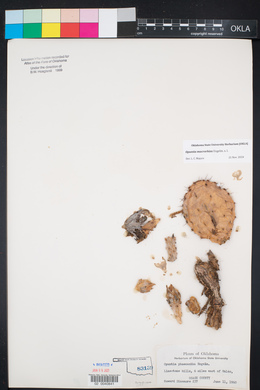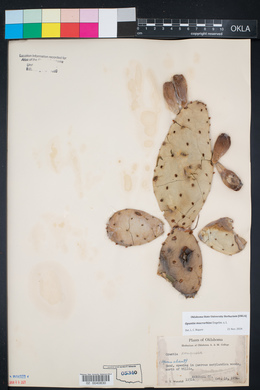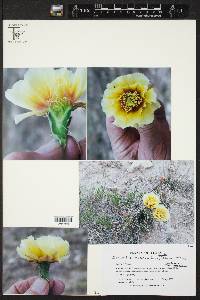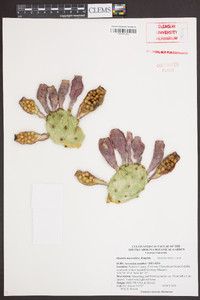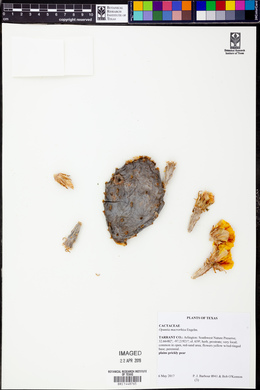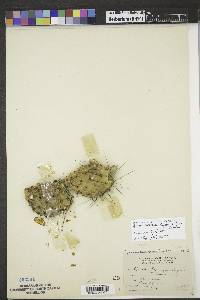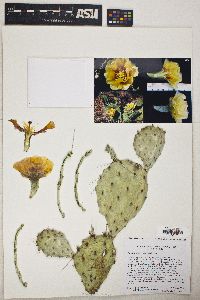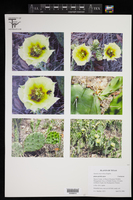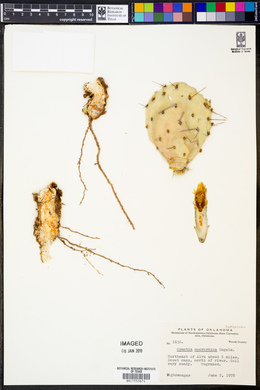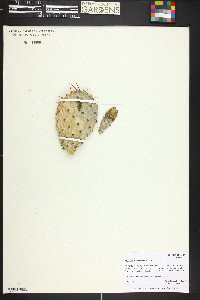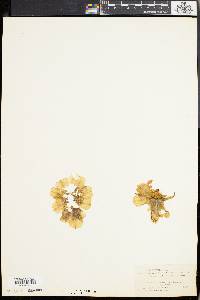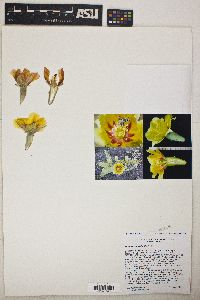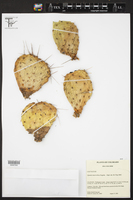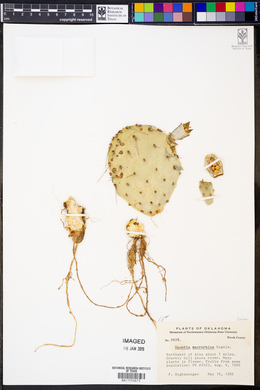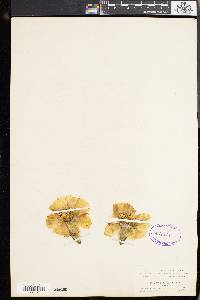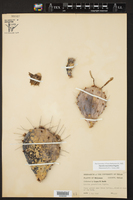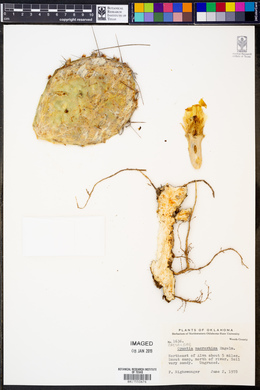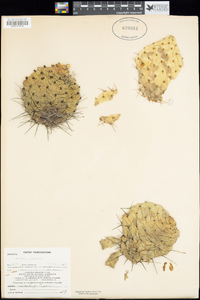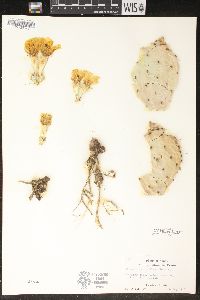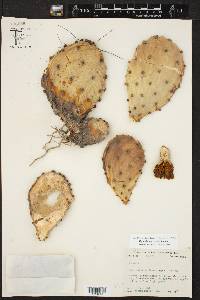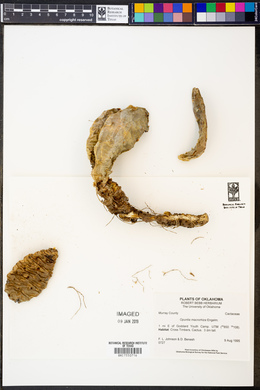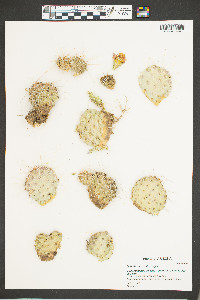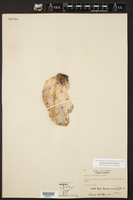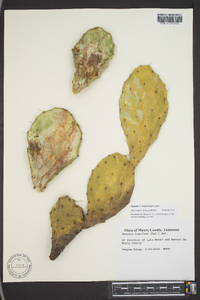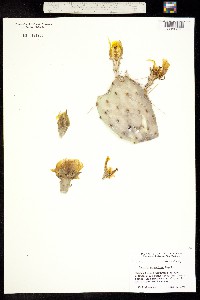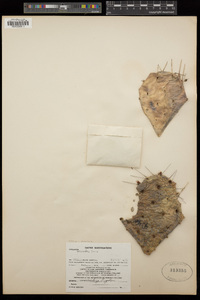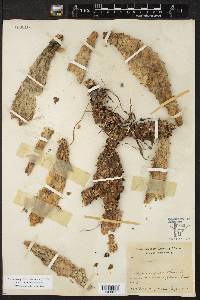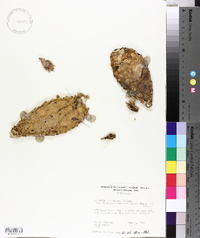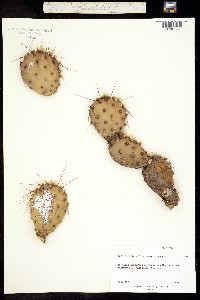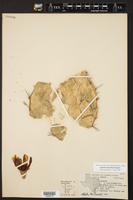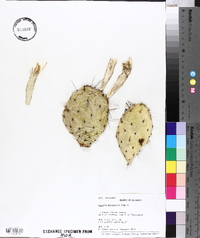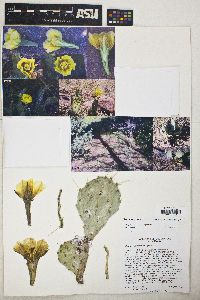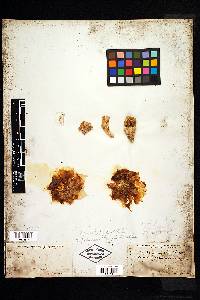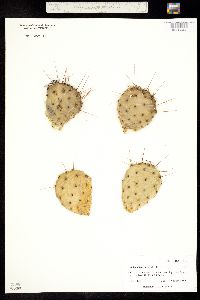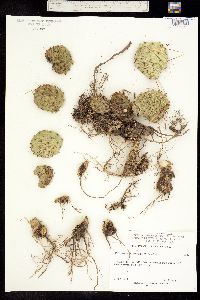Opuntia macrorhiza
|
|
|
|
Family: Cactaceae
Twist-Spine Prickly-Pear, more...twistspine pricklypear, plains twistspine pricklypear, prickly pear, grassland pricklypear (es: nopal)
[Opuntia fusiformis Engelm. & J. M. Bigelow, moreOpuntia roseana Mackensen] |
Shrubs, forming clumps, 7.5-16 cm, sometimes from tuberlike rootstocks. Stem segments not easily detached, dark dull green, often cross wrinkled when stressed, flattened, obovate to circular, 5-11 × 3.5-7.5 cm, fleshy (to flabby and cross wrinkled when stressed), tuberculate, glaucous; areoles 5-6(-8) per diagonal row across midstem segment, oval to subcircular, 2-4 mm diam.; wool tan. Spines (0-)1-4 per areole, usually in distal areoles, erect to spreading, white to red-brown, acicular, straight, terete or 1 flattened, ± stout (0.5 mm diam. at base), longest to 60 mm. Glochids in dense tuft, pale yellow, tan to red-brown, aging brown, to 5 mm. Flowers: inner tepals yellow with red basal portions, 25-40 mm; filaments pale yellow; anthers yellow; style white; stigma lobes cream to yellowish. Fruits green to yellowish to dull red, stipitate, elongate-obovoid, 25-40 × 15-28 mm, fleshy, glabrous; areoles 16-28. Seeds tan, subcircular, 4-5 mm, thickish, warped; girdle broad, protruding to 0.5 mm. 2n = 44. Flowering late spring (May-Jun). Plains, chaparral, grassy woodlands, coniferous forests, sandy to loamy soils; 100-2300 m; Ariz., Ark., Colo., Kans., Mo., N.Mex., Okla., Tex., Utah; Mexico (Chihuahua). Opuntia macrorhiza hybridizes with the hexaploid O. engelmannii (apparently var. lindheimeri) forming the pentaploid O. ×edwardsii V. E. Grant & K. A. Grant. This hybrid is a small subshrub, 20-40 cm, with a mixture of widely spaced, unequal glochids and closely spaced, shorter glochids. Its major spines are gray, and its tepals are yellow or yellow with red bases. Those characteristics are similar to one parent or the intermediate of the two putative parents reported from Blanco and Guadalupe counties, central Texas.
Plant: Erect pad cactus, Clump-formers, to 35 cm tall, sometimes from tuber-like rootstocks. PADS dark green, glabrous, usually glaucous, fleshy to flabby, often cross-wrinkled with stress, obovate to subcircular, 5-11 cm long, 3.5-7.5 cm broad;AREOLES 5-7(-8) in diagonal row across mid-pad, oval to subcircular, 2-4 mm in diameter; wool tan Leaves: SPINES mostly in pads- upper areoles, white to red-brown, the major ones straight, rather stout (ca. 0.5 mm in diameter near base), erect and/or deflexed, (0-)1-4 per areole, the largest 2-6 cm long. GLOCHIDS pale yellow, tan to red-brown, aging brown, forming a well-developed, dense apical tuft, to 6 mm long Flowers: inner tepals yellow with red or reddish bases, 2.5-4 cm long; filaments pale yellow; style white; fresh stigmas yellow. Fruit: FRUITS green, yellowish, to dull red, elongate-obovoid, long-stipitate, spineless, fleshy, 2.5-4 long, 1.5-2.8 cm in diameter; areoles 12-26. SEEDS tan, subcircular, 4-5 mm in diameter, thickish, warped; girdle broad, protruding to 0.5 mm Misc: Sandy to rocky soils, plains, chaparral, grassy woodlands and coniferous forests;; 900-1850 m (2900-6100 ft.); May-Jul REFERENCES: Pinkava, Donald J. Cactaceae. 2003. J. Ariz. - Nev. Acad. Sci. Volume 35(2). Benson 1982, FNA 2003 Common Name: twistspine pricklypear Duration: Perennial Protected Status: No status in Arizona. General: Shrubby and clump forming with clumps 0.5-2 m wide and 8-13 cm high, the joints 6-10 cm long and 5-7 cm wide with stem segments not easily detached, the pads a dull dark green or bluish-green (often wrinkled when stressed), they are glaucous with 5-8 areoles per diagonal row across the middle of the stem, these are oval to sub-circular and 2-4 mm in diameter and usually distal with a tan wool. Spines: Spines mainly on the uppermost areoles that are white to red-brown with 1-6 spines per areole to 6 cm long, erect to spreading but mostly pointing downward, they are straight or slightly curved, with glochids in a dense tuft that are pale yellow, tan, to red-brown, aging brown, these to 5 mm. Flowers: Flower 5-6.2 cm in diameter and long, the tepals are yellow that sometimes have reddish centers, these 5-6 cm wide and 5 -6 cm long, the anthers yellow, the style greenish yellow and basally swollen. Fruits: Purple or reddish-purple and fleshy with sparse glochids, they are obovoid 2-4 cm long and 2-3 cm wide with a shallow cup at the top, with the fruit persistent for several months. Ecology: Found in sandy, loamy, or rocky soils in plains, chaparral, grasslands, pi-on juniper woodlands, and ponderosa pine forests from 2,000-8,000 ft (610-2438 m), flowers April-June. Notes: Our plants belong to var. macrorhiza. This species hybridizes or intergrades freely with O. martiniana and O. phaeacantha, producing plants intermediate in characters and very difficult to key. Ethnobotany: Fruit was traditionally eaten raw or dried and used as thickening agent for soups. Inner stems were boiled and fried. Inner stems were used as wound dressings or made into a drink to treat diarrhea. Cacti juice has also been shown to reduced blood sugar. Etymology: Opuntia from ancient root puncti for prickled, while macrorhiza means large rhizome. Synonyms: None Editor: SBuckley, 2010 Prostrate and spreading, forming mats to 1.5 m wide; usually some roots tuberous-thickened; joints of the stem mostly 6-10 נ5-7 cm, flat, orbicular to obovate; areoles on full-grown joints 15-30 mm apart, with (1-)3-6 spines 3.5-5.5 cm; fls yellow with reddish center, 5-7 cm wide; outer sep ovate, acute to acuminate; fr reddish-purple, 2.5-4 cm, juicy; seeds discoid with a rough, irregular, corky margin. Prairies and plains; S.D. to Ariz. and Tex., e. occasionally to Wis., s. Mich., Ill., and reputedly O. and Ky. May-July. (O. mesacantha; O. tortispina, misapplied)
O. polyacantha Haw., a similar western sp. with 6-10 spines per areole and dry frs, has been reported e. to Wis. and Mo. Gleason, Henry A. & Cronquist, Arthur J. 1991. Manual of vascular plants of northeastern United States and adjacent Canada. lxxv + 910 pp. ©The New York Botanical Garden. All rights reserved. Used by permission. |
|
|
|

